The post UNESCO World Heritage Site: Rock Drawings In Val Camonica | Italy appeared first on Europe Explored.
]]>Val Camonica stretches for almost 90 kilometres, and scattered over hundreds of locations on both sides of this expansive valley are the world’s greatest collections of prehistoric rock drawings. This UNESCO World Heritage Site gives us artistic insight into the culture, pastimes, and interests of the ancient world.
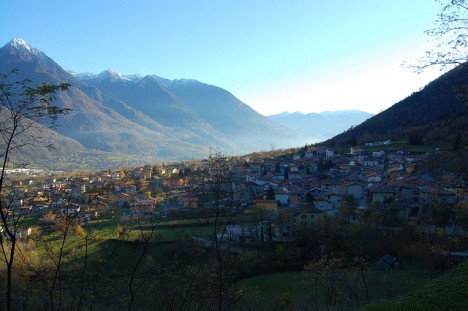
Val Camonica valley, Lombardy, Italy by Bernat Erasmus
The Great Gallery
The Valley lays claim to the most extensive collection of prehistoric petroglyphs on Earth; a rather impressive trophy for a rural region in the Alpine mountains of Italy!
It would seem that the inhabitants of this particular region, for reasons unknown, were intent on documentation and expression through the rock-based art-form. It is recorded that over 140,000 symbols and figures are carved into the Valley’s rocks. This staggering number is thought to have been achieved over a period of 8,000 years, and although UNESCO has formally recognised the previous number of incisions, it is thought that new discoveries raise the total somewhere between 250,000 and 300,000
Subjects of Superstition
The artistic works depict many different themes and subjects, providing an invaluable insight into the thoughts and minds of our creative ancestors.
The subjects of the rock drawings are diverse, and themes give us a glimpse into early agriculture, maps and constellations, as well as mysticism, war and magic! These early drawings are an unprecedented documentation of beliefs, traditions and triumphs.
In some cases, the figures and drawings seem to have been placed with no obvious order or logic, while others have a definite connection.
Visitors can see the showcase of impressive scenes of vibrant dances, historical hunts, ferocious fights, and mystical masterpieces that depict religious rites and ceremonies. These drawings seem to commemorate the culture of times past, however some of them are rather bizarre. The stranger drawings in this vast collection, through archaeologists’ analysis, have been described as less of documentation, and more an expression of ideas and early human thoughts.
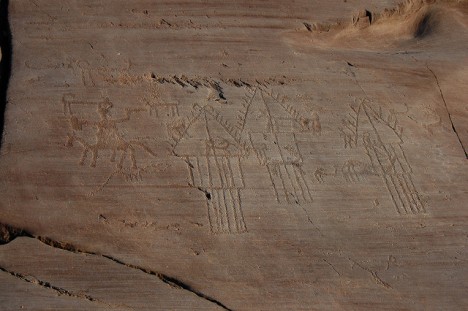
Rock drawings, Val Camonica valley, Lombardy, Italy by Bernat Erasmus
A Piece of History
The history of the petroglyphs spans an extra-ordinate amount of time, and many different periods are documented. Making such a discovery would be any historian or archaeologist’s dream!
The first incisions give us a snapshot of a time long before even the Iron Age. While they give us extraordinary pictures of prehistoric customs, the drawings continue throughout history, and even into the modern day! It is thought the custom of rock drawing in this region carried over from generation to generation, even through the Roman and Medieval periods. Interestingly, most of the drawings have been created using similar techniques, even though the tools must have changed somewhat over the timeline.
One amazing scene shows one of the valley’s tribes initiating new females, at a time when they began to meet new people. Their isolation seems to end around 1000 BC, and it was at this time that their art was at its peak. Many battle scenes were carved during this period, and although the tribe was introduced to other members of society – their introductions appear to be rarely friendly!
Conclusion
If any one location has earned its place as a site worthy of world heritage, it is this one.
There is an unparalleled span of ancient and intricate artwork found throughout the rock drawings in Val Camonica. Thousands of people from the world over have already enjoyed this once in a lifetime experience, and have witnessed the site for themselves. Why not count yourself as one of them, and visit the amazing site today?
Author Bio:
An article by Matt Scott who loves writing UNESCO travel articles and anything Italian. If you need to hire a rental car for your trip to the Val Camonica region visit the comparecarrentals.co.uk car rental comparison search engine.
The post UNESCO World Heritage Site: Rock Drawings In Val Camonica | Italy appeared first on Europe Explored.
]]>The post The Most Stunning Art Deco Buildings in London | United Kingdom appeared first on Europe Explored.
]]>Battersea Power Station
 Battersea Power Station is made up of two power stations, named A and B, and remains the largest brick building in the Europe. The first power station was built just before world war two, and the second power station became operational in 1953. Until 1983, Battersea Power Station was used as a coal-fired generator of electricity. It is a Grade II listed building and was designed by architects Sir Giles Gilbert Scott and Theo J. Halliday. Art deco fittings in the control room of A station displayed the influence of Halliday. It was recently purchased and will be redeveloped as a multi-purpose housing complex – although a mandate remains that the facade and any listed part must be maintained.
Battersea Power Station is made up of two power stations, named A and B, and remains the largest brick building in the Europe. The first power station was built just before world war two, and the second power station became operational in 1953. Until 1983, Battersea Power Station was used as a coal-fired generator of electricity. It is a Grade II listed building and was designed by architects Sir Giles Gilbert Scott and Theo J. Halliday. Art deco fittings in the control room of A station displayed the influence of Halliday. It was recently purchased and will be redeveloped as a multi-purpose housing complex – although a mandate remains that the facade and any listed part must be maintained.
Photo of Battersea Power Station, London, UK by Aurelien Guichard
BBC Broadcasting House
 Broadcasting House is the home of the world renowned British Broadcasting Corporation. Designed in an art deco style, work on the building began in 1932, and was completed in two years. The building’s exterior was designed by George Val Myer, with help from M T Tudsbery, who was a civil engineer employed by the BBC. The interior of the building was designed by Raymond McGrath. Currently, Broadcasting House is being renovated and is home to Radio 3 and Radio 4.
Broadcasting House is the home of the world renowned British Broadcasting Corporation. Designed in an art deco style, work on the building began in 1932, and was completed in two years. The building’s exterior was designed by George Val Myer, with help from M T Tudsbery, who was a civil engineer employed by the BBC. The interior of the building was designed by Raymond McGrath. Currently, Broadcasting House is being renovated and is home to Radio 3 and Radio 4.
Photo of BBC Broadcasting House, London, UK by keriluamox
Claridge’s
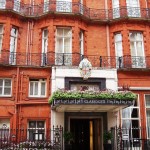 Claridge’s is one of the most famous luxury hotels in London, and opened in 1812, when it was originally called Mivart’s Hotel. The Claridge family purchased the hotel in 1854. A visit by Queen Victoria boosted Claridge’s reputation as an elite hotel, and it has had entertained an exclusive host of guests down the years. The original Claridge’s hotel was replaced in 1898 by George Trollope & Sons. Claridge’s was to become recognised as a fine example of art deco style, when Basil Ionides re-designed both the hotel’s restaurant and some of its suites in the 1920s.
Claridge’s is one of the most famous luxury hotels in London, and opened in 1812, when it was originally called Mivart’s Hotel. The Claridge family purchased the hotel in 1854. A visit by Queen Victoria boosted Claridge’s reputation as an elite hotel, and it has had entertained an exclusive host of guests down the years. The original Claridge’s hotel was replaced in 1898 by George Trollope & Sons. Claridge’s was to become recognised as a fine example of art deco style, when Basil Ionides re-designed both the hotel’s restaurant and some of its suites in the 1920s.
Photo of Claridge’s, London, UK by Ewan Munro
OXO Tower
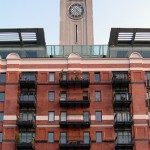 Built in the late 1800s, the Oxo Tower’s origins were as a power station. It obtained its current name after being bought by the manufacturers of the Oxo cube, the Liebig Extract of Meat Company. The original building was radically redesigned by Albert Moore in the late 1920s, when, notably, the word ‘Oxo’ was spelt out by the two circles and cross design. It was designed in a way that reflected the popularity of art deco at the time. It was in the 1990s that the Oxo Tower became used as a multi-purpose building that included shops, a restaurant, space for exhibitions, and even housing.
Built in the late 1800s, the Oxo Tower’s origins were as a power station. It obtained its current name after being bought by the manufacturers of the Oxo cube, the Liebig Extract of Meat Company. The original building was radically redesigned by Albert Moore in the late 1920s, when, notably, the word ‘Oxo’ was spelt out by the two circles and cross design. It was designed in a way that reflected the popularity of art deco at the time. It was in the 1990s that the Oxo Tower became used as a multi-purpose building that included shops, a restaurant, space for exhibitions, and even housing.
Photo of OXO Tower, London, UK by ChrisO
Royal Institute of British Architects
 Home of the Royal Institute of British Architects, architect George Grey Wornum designed the Portland Place art deco building, which was opened in 1934 by King George V and Queen Mary. Wornum’s design was deemed to have been the best out of 3,600 submitted entries. It is a Grade II listed building, and the general public have access to the library and exhibition galleries. Also included in the building is a restaurant, cafe and bookshop. For any fan of Art Deco style, this building is not to be missed.
Home of the Royal Institute of British Architects, architect George Grey Wornum designed the Portland Place art deco building, which was opened in 1934 by King George V and Queen Mary. Wornum’s design was deemed to have been the best out of 3,600 submitted entries. It is a Grade II listed building, and the general public have access to the library and exhibition galleries. Also included in the building is a restaurant, cafe and bookshop. For any fan of Art Deco style, this building is not to be missed.
Photo of Royal Institute of British Architects, London, UK by Oxyman
Wandering the streets of London is a great way to experience the myriad of styles dotted all over the city – and Art Deco lovers have plenty to feast their eyes on.
Mike is a freelance writer who loves exploring the architecural feats of the great city of London. Mike is currently writing on behalf of Claridge’s hotel – a world famous luxury hotel who also offer private dining.
The post The Most Stunning Art Deco Buildings in London | United Kingdom appeared first on Europe Explored.
]]>The post Top 6 Football Stadiums in Portugal appeared first on Europe Explored.
]]>Football lovers from around the world will know and appreciate the quality of teams and players produced by the country in recent years, and their stadiums don’t disappoint either.
With many being newly built for the European 2004 football tournament, Portugal really does have some of the best stadiums in Europe on offer for the sports mad traveller.
Here are 6 of the best for you to visit:
1. Estádio da Luz – SL Benfica

Photo by Crystian Cruz
In terms of highest capacity the Estadio do Sport Lisboa e Benefica (Estadio da Luz) wins the day holding a massive 65,647 supporters.
It is home to Benfica who are a team in the Primeira Liga which is the top division of the Portuguese football leagues.
Despite being one of the largest and well supported clubs in Portugal, Benfica’s last Primeira Liga title came back in the 2009/2010 season.
2. Estádio do Dragão – F.C. Porto
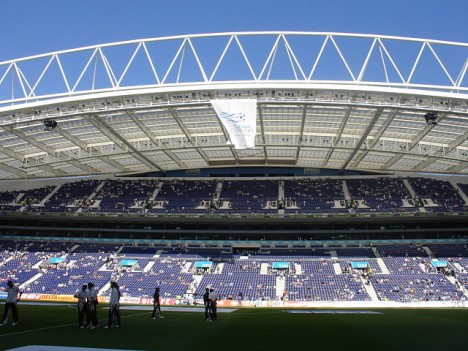
Photo by senalbuquerque
Located in Porto and home to the F.C. Porto football club, the Dragao can house just under 51,000 fans making it an impressive stadium by any measure.
Opening for business in late 2003 this stadium has seen its fair share of trophies over its short history including 7 Primeria Liga titles, 4 Portuguese Cups and a UEFA Cup amongst others.
3. Estádio José Alvalade – Sporting Clube de Portugal

Photo by blvesboy
Another Lisbon based stadium, the Jose Alvalade is the home ground of Sporting and has a capacity of just under 51,000 similar to the Dragao of Portugal.
The Jose Alvalade also opened its doors in the second half of 2003 and was built with the Euro 2004 football tournament firmly in mind like many of Portugal’s top capacity stadiums.
Unfortunately Sporting have not won the league title since moving into their new stadium, but have won a Portuguese Cup back in 2007.
4. Estádio Cidade de Coimbra - Académica de Coimbra
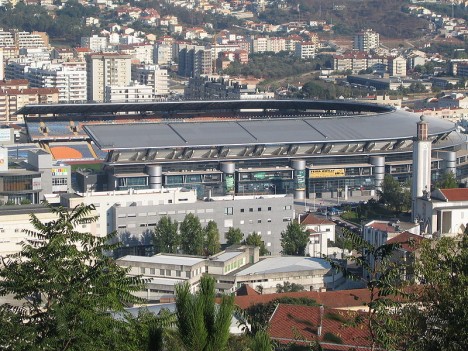
Photo by Elapsed
Another relatively new stadium built for the Euro’s, the base of Academica (Portugal’s oldest registered football club) has a maximum game capacity of almost 30,000.
Located in Coimbra which is further north up the western coast of Portugal from Lisbon, Academica are classed as being in the second tier of Portugese football having never managed to clinch a league title.
The stadium has hosted some big pop acts in recent years including the massive U2 360 tour.
5. Estádio Nacional
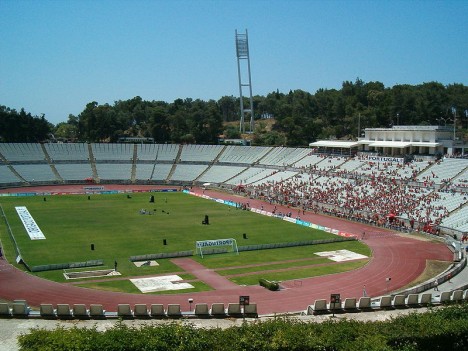
Photo by Koshelyev
The National stadium of Portugal is in Lisbon however it is not really used very much anymore after falling into some disrepair according to many Portugal football fans.
The nation side tends to use one of the other Lisbon stadiums for their home games now, but the Estadio Nacional does still host the Portuguese Cup final every year.
It has a seating capacity of around 38,000 and is well worth a visit if you’re staying in or around Lisbon.
6. Estádio Municipal de Braga – Sporting Clube de Braga
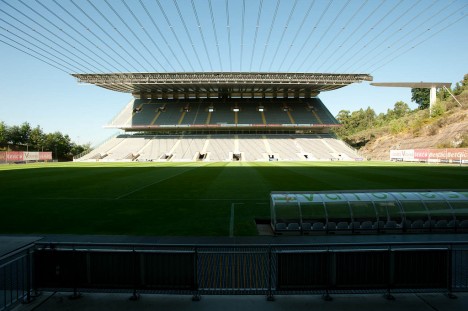
Photo by LeonL
No list of Portuguese football stadiums would be complete without this one, which is home to Braga and has a capacity of slightly over 30,000.
Probably one of the most striking stadiums in Europe, it has been built on the side of the quarry of Monte Casto and the quarry wall sits directly behind one of the goals, at the other end there is also no stand giving panoramic views of the city of Braga in the distance.
A truly wonderful design that should not be missed.
Darren Atkinson is a keen football fan and runs a holiday accomodation website found at: www.villasinportugal.com.
The post Top 6 Football Stadiums in Portugal appeared first on Europe Explored.
]]>The post How the London Underground has Changed appeared first on Europe Explored.
]]>
London underground / Amanda Vincent-Rous
The Underground, like all train-lines, has to be reliable and fast; if it isn’t, then people are late for work, the companies fail to make profit and the economy suffers. While Britain is far from having the most reliable and on-time underground system, it is still very impressive – just don’t expect to be comfortable in the tubes.
As a result, the London Underground has changed quite a lot over the years. As the world’s first underground railway, 1863 was an important year for London’s transport vision. While the official title of ‘London Underground’ would only come into play in 1985, the underground rail network in London has been in full flow for well over a century, transporting passengers on a daily basis.
Now carrying three million passengers every day, the London Underground is a business in itself, but it hasn’t always been like that. Back in 1863, the first line was laid and stretched just under four miles between Paddington and Farrington Street. It wasn’t much, but it was a start of something that would turn into a massive line of railway across the capital.
1880 saw the opening of the first Tube tunnel, from the Tower of London to Bermondsey, which represented another milestone and leap for the evolution of the railway network underground. As the world entered the 20th century, electric lines were introduced to the District and Circle route, cementing the future of the concept.
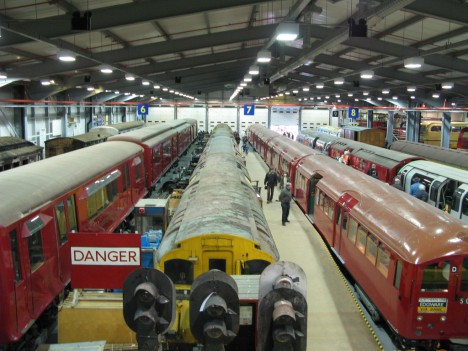
London transport museum / Julian Tysoe
Changes and additions to lines and new stations were made as the decades rolled by until the exciting introduction of dot-matrix train destination indicators in 1983. This was perhaps a big sign of the more modern-approach to the London Underground as we pushed towards the end of the 20th century.
Tragically, the late ‘80’s saw a fatal fire at King’s Cross killing 31 people which not only shook the nation but called for new safety and fire regulations to be introduced. As we welcomed in the 21st century, 2002 saw the Oyster card for the first time in the London Underground – something that is still used to this day.
It may not be comfortable in the tubes for the passengers – especially at peak times – but the Underground remains a massive part of people’s everyday lives for commuting and pleasure. Who knows where the London Underground is going in the next 100 years (my money is on maglev technology), but one thing is for certain: it will definitely still be there!
This gaze at the glorious London undergound was contributed to us by chessingtonholidays.co.uk – hoping you’ll pay a visit next time you’re in London!
View How the London Underground has Changed in a larger map
The post How the London Underground has Changed appeared first on Europe Explored.
]]>The post The Roman Colosseum – one of Rome´s most iconic sites | Italy appeared first on Europe Explored.
]]>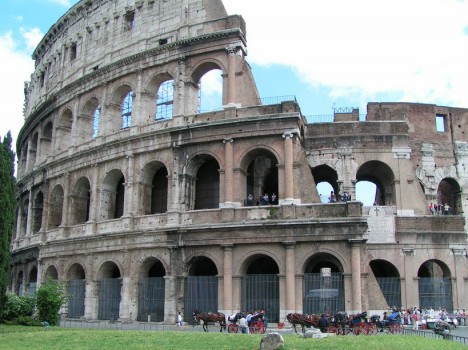
Roman Colosseum / Photo by admin
History
The Colosseum was commissioned by the Emperor Vespasian in the year 72 A.D. and later completed under the rule of his son, Titus in 82 A.D. The final modifications were completed during the reign of Domitian, the brother of Titus, who ruled from 81-96 A.D. The original name for the Colosseum was the Flavian Amphitheater, which was derived from Flavius, the family name of the emperor and his sons.
Unlike other amphitheaters built before it, the Colosseum was built in the heart of Rome as opposed to in the outskirts. It was literally erected in place of the lake that Emperor Nero had designed in the landscaped gardens of his villa Domus Aurea. The area was previously densely inhabited but after the Great Fire of Rome of 64 A.D. destroyed the homes in the area, Nero commandeered the land to build his villa. The choice of building site represents a symbolic return of the land to the people after it had been appropriated by Nero.
Uses
In ancient Rome, the Colosseum was used to host gladiatorial contests, wild animal fights, executions, dramas, reenactments of battles and other public spectacles. At the inaugural spectacle in 80 A.D., over 9,000 animals were killed in wild animal fights. The gladiatorial contests and animal fights continued for several centuries. The last known gladiatorial contests were in the year 435 and the last known animal fights were held in 523.
During the medieval period, the Colosseum served as a castle, a cemetery and a workshop. Later, during the 16th and 17th centuries, the Catholic Church began to show interest in the Colosseum. One church official proposed setting up a wool factory in the amphitheater to provide employment to prostitutes. Another official managed to authorize its use to host bullfights though the authorization was later revoked. Pope Benedict XIV consecrated the Colosseum because he claimed it was the place where Christian martyrs had died years before although no historical evidence supports this claim. Subsequent popes and Benito Mussolini promoted restoration and excavation projects as well.
Structure
The size and excellent preservation of the Colosseum rarely fails to impress the visitor. The amphitheater is elliptical, measuring 88 meters long and 156 meters wide. The 80 arched entranceways provided access to the 55,000 spectators who could be accommodated in the amphitheater at any time. The seats are arranged in tiers. Spectators in ancient Rome were distributed among the tiers according to their social strata. Separate areas were proportioned for senators, the non-senatorial noble class, plebeians and wealthy citizens. Interestingly, actors, gravediggers and former gladiators were banned from the Colosseum.
The Colosseum Today
Today, the Colosseum is one of Rome´s principal tourist destinations, attracting millions of visitors per year. It is one of the most well-known symbols in Rome and is well worth a visit for any tourist in Rome.
While you enjoy your travels around Rome, you’re going to need somewhere to stay. Why not check out some of the beautiful Rome vacation rentals listed on Worldwide-Accom.com as they’re all fully inspected by the website operators to ensure you’ll be booking in to a safe and secure apartment!
View The Roman Colosseum – one of Rome´s most iconic sites Italy in a larger map
The post The Roman Colosseum – one of Rome´s most iconic sites | Italy appeared first on Europe Explored.
]]>The post Manchester Airport Hotels Are Lovely To Stop In | United Kingdom appeared first on Europe Explored.
]]>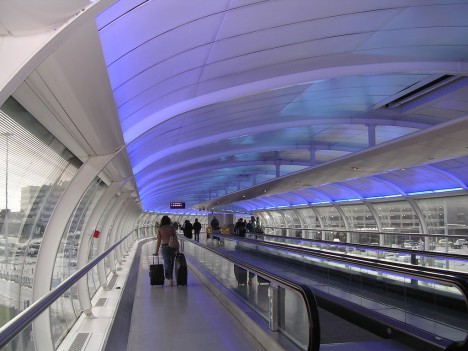
Photo licensed under the Creative Commons, created by Terry Whalebone
Very few airports in the world can handle what is known as “Code F” aircraft, but this one can, and in fact, has been having the Concorde land there for a long time. Now it even handles the Airbus A380, which is currently the biggest passenger airliner today. This plane is even a double decker besides being a wide-body.
Wartime and After
During its time, the Ringway Airport was of tremendous importance to the RAF, and this location trained a great number of parachutists. Its various terminals have been added to since the war of course, and there is a tremendous amount of room for expansion, especially since the 1972 opening of the M56 motorway for use to reach the airport. Furthermore, since wartime, sky links and travelators have also been added.
Currently, the airport boasts three separate terminals all of which are in constant use. Also added have been special rooftop smoking terraces, many additional executive lounges as well as some great shops and of course restaurants. Evidently, the airport also has a very large World Freight Terminal that opened in 1986. Security at the airport is being handled by the Greater Manchester Police.
The Manchester Airport has its own railway station called the Manchester Airport Railways Station, and it came into use in 1993. It currently has three different rail platforms handling over 300 trains per day to take care of the huge amount of people who come to the airport by train. The airport also receives over 500 buses daily as well as over 100 coaches. There are plans to open a Manchester Airport tram station in 2016.
Aircraft Spotting
Because the public has always been interested in aircraft spotting, a Runway Visitor Park was opened in 2010. In addition, there is now a café and a store located there, which sells aviation-related items. A number of retired aircraft are available for sightseeing as well. Although there are a number of Manchester Airport hotel accommodation in the area, there currently is one hotel on Ringway road that also has a public house for those who wish to have a beer.
Accidents
Ever since the Manchester Airport has been open, there have been very few accidents. However, in March 1951, a cargo aircraft crashed, which was caused by icing in the carburetor intakes. The captain had unfortunately failed to utilise the plane’s heat controls. In 1957, a plane on final approach crashed due to flap failure. In 1967 a plane had to abort its approach to Manchester Airport and suffered a loss of engine power and therefore, crashed. Finally, in 1969, a small plane crashed on takeoff, and in 1985, a larger plane carrying 55 people suffered engine failure due to incorrect repairs, and it failed to take off causing a fire in the cabin.
Pam is a full time freelance writer and works on guest posting projects. If you are interested in her services please contact Pam at [email protected].
View Manchester Airport Hotels Are Lovely To Stop In United Kingdom in a larger map
The post Manchester Airport Hotels Are Lovely To Stop In | United Kingdom appeared first on Europe Explored.
]]>The post Unusual Bridges in the United Kingdom appeared first on Europe Explored.
]]>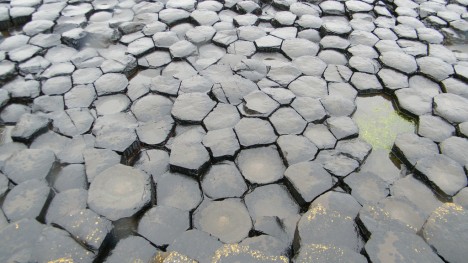
Photo licensed under the Creative Commons, created by Sean Lucas
The Giants Causeway
OK, so it’s not strictly a bridge, but you can’t make a list of bridge-like forms in the UK and Ireland without mentioning the Giants Causeway. It’s formed of about 400 interlocking basalt columns and is the result of an ancient volcanic eruption. In legend, the causeway was built by an Irish warrior named Fionn, in order to beat his Scottish challenger Benandonner. Fionn never faced his rival, but hid under a blanket and his wife Oonagh pretended that he was their baby. Benandonner is said to have seen this giant baby and fled in terror, imagining that Fionn must be huge indeed.
Chelmer Viaduct
A viaduct is a bridge composed of several small spans. They are often used to allow for multiple types of traffic to cross across a space. They can span land or water. The viaduct at Chelmer is due for refurbishment to turn it into a greater beauty spot. The current viaduct and bridge are both due for replacement because of their great age. To remain a functioning bridge and avoid being slapped with a weight restriction, the viaduct needs to be overhauled. They will be redesigned by a leading architecture firm – turning this old viaduct into one of England’s more unusual bridges.
Reflections Bridge, Loch Awe Scotland
With a very evocative name, the Reflections Bridge at Loch Awe Scotland is situated in one of the top 5 most beautiful Lochs in the country. Loch is the Scottish word for lake, and there are very many lochs in Scotland. Loch Awe is the longest inland loch, but not the largest by surface area (that’s Loch Lomond), or the deepest (Loch Ness). It’s pretty narrow, which means that building a bridge from one side to the other is a possibility. The Scottish lochs are known for their clear and still reflections, which makes the Reflections bridge a great place to take a camera and a must-see when visiting the North Argyll Glens.
Architectural landmarks are best when they complement nature and these bridges certainly do. Britain is known for the engineering explosion that took place in the 19th century and also for its stunning continuous coastline. There are 24 bridges in London alone and the longest of these is the Humber bridge.
Robert Jefferson is an English writer who likes writing about architecture, travel and unusual bridges.
View Unusual Bridges in the United Kingdom in a larger map
The post Unusual Bridges in the United Kingdom appeared first on Europe Explored.
]]>The post Arc de Triomphe – Napoleon’s pride in Paris | France appeared first on Europe Explored.
]]>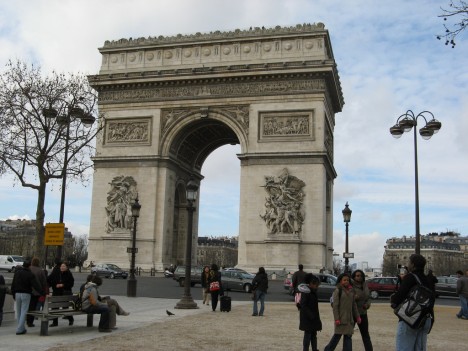
Photo licensed under the Creative Commons, created by Olivier Bruchez
This 50 meters high and 45 meters wide arch was built by Napoleon Bonaparte as a sign of his power and victory of the Great Army – Grande Armée in many battles. Its designer was the French architect Jean-François-Thérèse Chalgrin. The construction started in 1806 and lasts the entire 30 years. Last update was completed in the year 1836, during the reign of Louis Philippe d’Orléans.
Triumphal Arch became almost immediately an important place for great national celebrations and funerals. Also, the deceased Emperor Napoleon was in 1840 transferred through the Arc to Les Invalides during the funeral ceremony. In the 19th century, Baron Haussmann decided to transform the image of the city and Arc de Triomphe became the center of Paris. Today, the Arc is a cross of 12 wide boulevards. The site is known as the Charles-de-Gaulle-Etoile and is bordered by the main transport arteries, which actually form the first organized roundabout in the world.
The main facade of the arch is decorated with four massive statues showing a victorious battles of the French Revolution in 1789 and the First French Empire. Along the top edges are shields engraved with the names of battles of the Great Army. Following the model of Roman arch, the Arc de Triomphe is amended with The National Anthem of France also known as the Marseillaise, made by the sculptor Francois Rude.

Photo licensed under the Creative Commons, created by Paul
If you want to enjoy a wonderful panoramic view of Paris, take the elevator to the observation terrace on the upper floor. From a height you can see the Louvre, Place de la Concorde – the largest square in Paris and the modern district La Defense. You will appreciate the pleasant atmosphere in the local museum, or watch short films about the Arc.
The arch serves as a national monument to all Frenchmen, fallen in many wars that took place and still take place anywhere in the world.
Under the Arc are also the remains of a major French poet, writer and author of Les Miserables, Victor Hugo. Currently, the Arc de Triomphe serves as the end of Tour de France.
Paris offers lots of holiday apartments for rent, camping sites or luxurious hotel rooms so it should not be a problem to choose the right accommodation for you.
View Arc de Triomphe – Napoleon’s pride in Paris France in a larger map
The post Arc de Triomphe – Napoleon’s pride in Paris | France appeared first on Europe Explored.
]]>The post Selinunte – ancient Greek archaeological site in Sicily, Italy appeared first on Europe Explored.
]]>Archeological site is located west of the railway station Selinunte and consists of two areas: Templi Orientali (Eastern temples) and the Acropolis. Tour through the locations takes 2-3 hours.
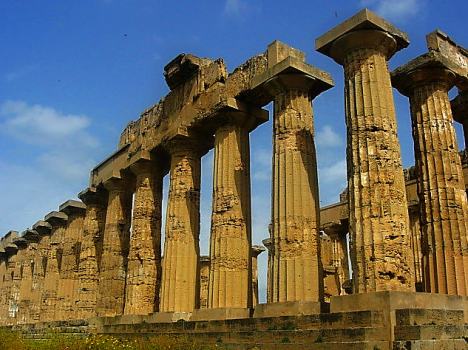
Photo licensed under the Creative Commons, created by Chiara Marra
The first area includes three temples, which probably originally had a common protective wall. North Temple, situated at the entrance to the complex, was one of the largest Greek temples ever (113x54metres). Construction began in 550 BC but due to a continuing war threats, the temple was never completed. Only one column survived of the originally 46 columns. On the opposite, southern side of the road leading to the acropolis, is another temple (66x27metres), built between 560-540 BC. It had originally 30 columns. In the purest Doric style is built its southern neighbor (the early 5th century BC). It measures 70x28metres and is reconstructed, so we can admire its 36 columns (four beautiful metopes are stored in the National Museum in Palermo).
From these three temples, you can follow the 1.8 km long winding road leading along one of two Selinunte’s ports to the acropolis. During the way you pass the remains of two other temples that were built in 490 to 480 BC. Then you can find there the Hellenistic temple (the largest and oldest temple in this area, 64x24metres). It dates from the mid-sixth century BC (42 columns of the original 12 left, three metopes are in a museum in Palermo) and finally the last temple (56x24metres) from the years 570 to 554 BC. Furthermore there are the remains of ancient dwellings in the neighborhood. At the northern end of the Acropolis you can see the remains of the former main gate of the ancient fortifications. About a mile away there are the ruins of the Sanctuary of Demeter Malophoros and the remains of three other shrines.
Today the village of Selinunte is a small fishing village with nice beaches.
View Selinunte – ancient Greek archaeological site in Sicily, Italy in a larger map
The post Selinunte – ancient Greek archaeological site in Sicily, Italy appeared first on Europe Explored.
]]>The post The world´s longest tree top walk in Bavarian Forest | Germany appeared first on Europe Explored.
]]>Tree Top Walk is the longest trail of that kind in the world, with a total length of 1300 metres. You can enjoy unspoilt nature at a height of 8-25 meters above the ground. The experience of walking through mixed forest is extended with three stations with a rope adventure elements, the swaying bridge, trapeze and the beam, which thrill not only children but also adults.
Walkway ends with 44 meters high observation tower, from which you can enjoy breathtaking views of the surrounding nature. In clear weather you will even be able to see the north ridge of the Alps.
Both the trail and also the tower are barrier-free. Admission is €8 for adults, €6 for children of 6+ years, family ticket costs €19. The trail is open year round except for Christmas Day, every day from 9:30 am, according to an annual period closes at 15:30, respectively, at 18:00 or 19:30. In bad weather, such as storm or hurricane, the trail is closed.
For further details visit the official site of The world´s longest tree top walk.
View The world´s longest tree top walk – explore nature in Bavarian Forest National Park Germany in a larger map
The post The world´s longest tree top walk in Bavarian Forest | Germany appeared first on Europe Explored.
]]>